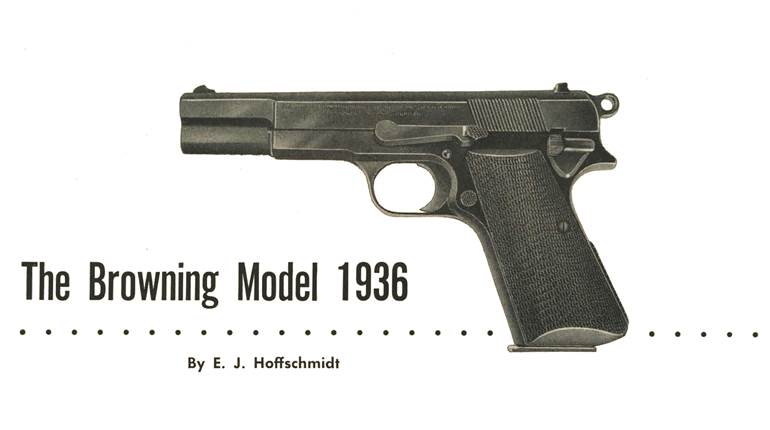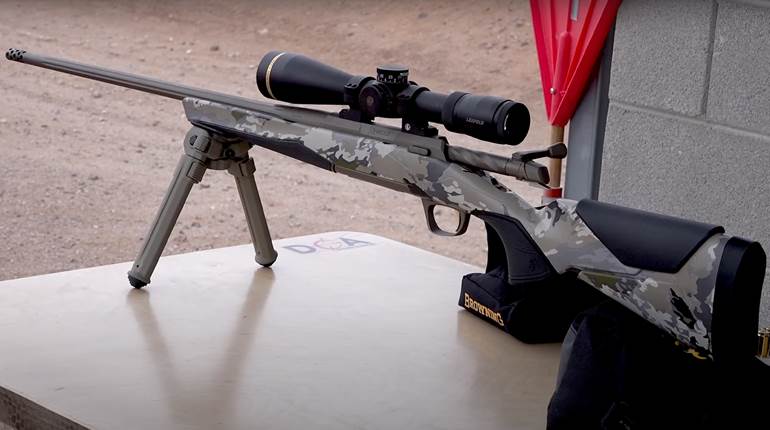
It was a very short stalk – too short, in fact. Normally the climbing, running or sneaking that follows the initial sighting of an animal in spot-and-stalk hunting enables a hunter to get over that first rush of adrenaline. But this time it happened all too quickly, and as I eased the rifle into my shooting sticks, I could barely hear the guide give me the range, his voice a slur that droned weakly behind my deafening breathing and the bass-drum rhythm of my heartbeat – until the crack of the rifle.
I was hunting black bear in northern British Columbia, and as I stomped around the pines and glassed the ridges and log roads that loosely connect this vast expanse of scenic beauty and harsh terrain, it occurred to me that the trek presented a new first. It wasn't the big, toothy bears, or even hunting a locale that required a passport; instead, the hunt had given me the opportunity to use the first Winchester semi-automatic, center-fire sporting rifle manufactured during my lifetime.
Produced from 1961 to 1973, Winchester's earlier semi-automatic rifle, the Model 100, was gas-operated and chambered for .243 Win., .284 Win. and .308 Win. A little more than 260,000 were manufactured. With a three-lug bolt, detachable box magazine, hand-checkered American stock and the ability to be quickly disassembled by removing two stock screws and four pins, the Model 100 was reviewed favorably in American Rifleman (July 1960, p. 21) and by the shooting public. Then it was gone.
Now, in the wake of the closure of the USRAC manufacturing facility in New Haven, Conn., the new Super-X Rifle (SXR), produced by parent company Fabrique Nationale in Herstal, Belgium, gives Winchester its first center-fire semi-automatic in more than three decades. And it's obvious even at first glance that this is not your father's semi-auto.
The SXR is based on the BAR ShortTrac and LongTrac rifles, which are produced by USRAC's sister company, Browning. Like the BAR, the SXR exudes the modern styling and influence of its European heritage. Built on an aluminum receiver, the SXR features a two-piece, walnut stock and fore-end that exhibits sleek, forward-sloping angles. It feeds from a detachable box magazine, and there is no external bolt release; only an empty magazine in the rifle will hold the bolt to the rear. A polymer trigger assembly contains a single-stage trigger; a cross-bolt safety is located directly to the rear of it. The stock is checkered on the pistol grip and fore-end, and a thick, black rubber recoil pad provides a comfortable mount. The Belgium-made, hammer-forged barrel wears a high-polish blue finish; the rifle has no sights; however, the receiver is drilled and tapped for scope bases.
Chambered in both short- and long-action cartridges, including .30-'06 Sprg., .270 WSM, .300 WSM and .300 Win. Mag., the SXR can handle magnum stress despite the aluminum receiver because Browning engineers employed a rotary, eight-lug bolt that locks into a barrel extension. The arrangement is reminiscent of many existing shotgun designs. This direct steel-to-steel lockup allows the SXR to take advantage of the weight saved by the unstressed aluminum alloy receiver. The barrel and barrel extension are locked to the receiver by means of a split block and two machine screws.
The SXR is a gas-operated, semi-automatic working on the short-stoke-piston method of operation. Upon firing, expanding propellant gases pass through a port in the barrel and into the gas cylinder beneath it to drive a piston rearward. The piston, in turn, pushes the inertia block, which compresses the action spring while maintaining engagement with the bolt assembly via two shotgun-like action bars. During bolt travel, the bolt assembly and action bars ride along raceways cut into the side of the receiver walls.
As the bolt assembly travels rearward, a sliding-plate type extractor withdraws the empty case before a plunger-style ejector kicks it from the receiver. On the bolt carrier's return, a new cartridge is stripped from the box magazine. The action spring then drives the entire mechanism forward again, whereupon the rotating bolt head rotates 60 degrees by means of a cam pin in the bolt carrier and re-engages the barrel extension.
Disassembly of the SXR begins with the rifle unloaded and the bolt home in its forward most position. Then, using a 9 mm wrench or a small punch, the sling swivel stud on the forward, underside of the fore-end can be removed, and the fore-end attachment nut on the forward end of the fore-end can be loosened (not removed; this part is captured). Now the fore-end can be slid forward and away from the receiver and barrel.
With the bolt still closed, the left action bar can now be removed by pulling the forward end away from the inertia block and then out of the receiver. Before the right action bar can be removed, however, the bolt lock spring must first be removed by prying it out of engagement using a flathead screwdriver. Be careful when removing this part; heavy spring tension will send it airborne as I discovered during disassembly/assembly. Next, remove the bolt lock pin and then pull the bolt lock forward and out of the receiver. Now the right action bar can be removed in the same manner used previously.
Next, using a small punch, drive out the roll pin, left to right, located just forward of the bolt lock pin. With the roll pin removed, grasp the action spring and compress it forward, away from the action to remove the recoil buffer assembly. While maintaining tension, slide the action spring fully rearward. Now the action spring, action spring slide assembly, inertia block and gas piston can all be removed. Remember that the action spring is still under considerable tension – failure to do so will create a javelin-like response that scatters small parts throughout your workspace. Also, the gas piston must remain inside the gas cylinder in order to remove the action spring guide.
Now all that remains is trigger assembly, which can be removed via two shotgun-style pins located at the base of the receiver. The trigger assembly can be removed completely independently from the rest of the rifle's components.
This is as far as Winchester recommends breaking down the SXR. Savvy readers might notice that instructions for disassembly of the bolt and its carrier were not included. Browning engineers felt that removal of these parts was too complex a process, and after getting the bolt assembly out for photos and back in again, I can attest to its complexity. We managed to do it, but it's a procedure best left to Winchester-authorized service centers.
It used to be assumed and accepted that all center-fire semi-automatic rifles maintained accuracy inferior to bolt-action designs. However, the SXR displayed excellent accuracy potential during testing, where cool-barrel groups were as tight as 1.36 inches. The groups opened significantly when the barrel heated up, the result of the hot, magnum chambering. But this is a gun that will be carried much more than it will be shot, and the lower-end accuracy results are much more in line with the true capabilities of the rifle.
That level of accuracy served me well in the field. As the loud report of the .300 WSM rolled through the river canyon, I saw the bear shudder then lower its head, tearing across the old logging road. For a moment I questioned the shot, quickly getting back into the gun and swinging on the bear, the rapid recovery readily apparent as I touched off a second shot when the crosshairs settled again on black fur. In a mere instant, the SXR had barked twice.
As we scurried up the steep embankment, we saw that the boar had not run far at all – it had only run across the road, folding neatly at the edge of the woods. The first shot, a 180-gr. Winchester XP3 bullet (October 2006, p. 62), had entered through the back, left hip, penetrated the length of the body and exited through the front, right shoulder. The second shot had hit just ahead of the first; each showed considerable tissue damage – an impressive display of terminal performance from the XP3.
Equally impressive was the SXR. The follow-up shot was surprisingly quick for a rifle chambered in .300 WSM, a cartridge that delivers a sharp, stout recoil impulse. But the gas-operation mitigated much of that blow, turning it into a longer, slower push. More importantly, it delivered precise shot placement when I needed it.
Winchester has a storied tradition in terms of semi-automatic rifles. Remember, it helped turn out the most important gun of World War II, the M1 Garand, before later developing the M1 Carbine. After the war, veterans shouldered Winchesters once again as the Model 100 established itself in deer camps across the country.
The Super-X Rifle borrows heavily upon that heritage, from its proven BAR-style method of operation, to the forward-thinking application of its design, to the big "W" logo on the gun itself, proclaiming boldly a new era in which the Winchester name will continue to ride.
Manufacturer: FN Herstal S.A., Herstal, Belgium; Fnherstal.com
Importer: U.S Repeating Arms Co.; (800) 333-3288; Winchesterguns.com
Caliber: .30-'06 Sprg., .270 WSM, .300 Win. Mag., .300 WSM (tested)
Action Type: Gas-operated,semi-automatic, center-fire rifle
Receiver: Aluminum alloy
Barrel: 24"
Rifling: Six-groove, 1:10" RH twist
Magazine: Removable, three-round box magazine
Sights: None, receiver drilled and tapped for scope bases
Trigger Pull: Single-stage, 4 lbs., 14 ozs. (tested)
Stock: Two-piece walnut; length of pull 14 1/8"; drop at heel 1 1/4"; drop at comb 7/8"
Overall Length: 43 3/8"
Weight: 7 lbs., 4 ozs.
Suggested Retail Price: $839






































